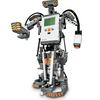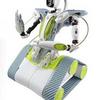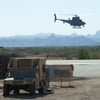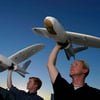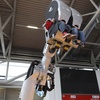Accuray Boeing Colin Angle Consumer Robotics CyberKnife CytoCare DARPA Education Financial Results Health Robotics Healthcare Robotics i.v.Station Industrial Robotics Industrial robotics International Space Station iRobot Liquid Robotics Lockheed Martin Medical Device Medical Robotics Medical robotics medical robotics Military Robotics Military robotics NASA Northrop Grumman Oceanography PackBot Remotely Operated Vehicle Research Robot Robotics ROV Schilling Robotics UAV Unmanned Aerial Vehicle unmanned aerial vehicle Unmanned aerial vehicle Unmanned Underwater Vehicle UUV
Boston Dynamics Shows Off PETMAN
October 31, 2009Is it a pet? Is it a man? Is it an anthropomorphic robot designed for the purposes of testing chemical protection clothing to be used by US Army soldiers?
No. No. And why, yes!
PETMAN is the latest creation of Boston Dynamics, the company that has designed a number of innovative robots, including BigDog, a quadruped robot for travel on rough-terrain, RISE, a robot that climbs vertical surfaces, and SquishBot, a shape-changing chemical robot that moves through tight space, and many others.
It's a little creepy, but still a pretty neat proof of concept. Check out the YouTube video for yourselves.
PETMAN can balance itself and move freely; walking, crawling and doing a variety of suit-stressing calisthenics during exposure to chemical warfare agents.
Boston Dynamics says that PETMAN will also simulate human physiology within the protective suit by controlling temperature, humidity and sweating when necessary, in order to closely simulate realistic test conditions.
According to the Boston Dynamics site, the PETMAN development program has a 13 month design phase followed by a 17 month build, installation and validation phase, with delivery of the robot taking place in 2011.
iRobot Forms Healthcare Business Unit, Intros President
October 31, 2009iRobot Corp. chairman and CEO Colin Angle, will discuss the role of robots in the future of healthcare at the upcoming TEDMED conference in San Diego, Calif.
Angle will also use the opportunity to introduce Tod Loofbourrow as president of iRobot's newly-created healthcare business unit. According to the company, the new business unit will explore the potential role of robotics as an assistive technology to promote wellness and enhance quality of life for seniors.
"Hiring Tod to lead our new healthcare business unit underscores the significance of this market opportunity, as well as the commitment the company is making in this space," said Angle.
Last week, iRobot announced third quarter results.
National Instruments Updates LEGO Robotics Software
October 27, 2009National Instruments has developed a new version of its intuitive drag-and-drop software that powers the LEGO MINDSTORMS NXT 2.0 robotics kits. The software offers new features such as color recognition, Bluetooth support and additional robot models.
The software is based on the widely adopted NI LabVIEW graphical programming environment, and will be included with all LEGO MINDSTORMS NXT 2.0 kits.
"We are constantly amazed at how graphical programming based on LabVIEW makes the NXT simultaneously powerful and easy to use," said Lars Nyengaard, director of innovation and robotics for the LEGO Group. "We're proud to have built the MINDSTORMS software around LabVIEW technology, which uses picture-based interaction that facilitates a fun and creative design experience for children.
Health Robotics Deploys i.v.Station in Madrid Hospital
October 27, 2009Health Robotics hailed the recent unveiling of i.v.STATION at Gregorio Maranon University Hospital in Madrid. Juan Jose Guemes, Health Secretary of State for Madrid's Regional Government toured the hospital's pharmacy aseptic compounding facilities, and inspected how i.v.STATION automatically prepared IV medications from Spanish drug vials in a variety of syringe sizes.
Meeting with reporters, Guemes said, "i.v.STATION permits much more efficient use of the medications, especially for high-cost and high-risk medications, focusing on patients requiring strict therapy guidelines and rigorous pharmaco-vigilance and control of the aseptic compounding process."
Guemes also announced plans to roll out the technology throughout the rest of the public hospital system in the Madrid Region
According to Health Robotics, i.v.STATION represents a revolutionary approach in the quest for safe, accurate, efficient, cost effective, and ready-to-administer intravenous patient doses, offering reduction of medication errors, ISO-compliant accuracy, improved sterility, and clinician labor savings: all within a scalable, cost-effective, distributed, and fail-safe architecture.
Health Robotics Announces Shipments, Innovation Award Win
October 12, 2009Health Robotics has announced the manufacturing, shipment, and subsequent field installation of the first five i.v.STATION post-prototype robots in the United States of America and in Spain within the September to November timeframe this year.
"These first five shipments of i.v.STATION represent the culmination of extraordinary work by our engineers and beta test customers and, I hope, also the start of a new era for Health Robotics in bringing our robots and software automation solutions out of the pharmacy basement and into the nurse stations and satellite pharmacies, as close as we can get to the patients," stated Werner Rainer, Health Robotics' CEO. About Health Robotics, in a statement.
Health Robotics also announced its i.v.STATION robot had won the Area Science Park 3L 3T Innovation Award.
According to AREA Science Park, who bestows the honor, the 3L 3T Innovation Award recognizes the "best technology products conceived or launched in 2009, the results of sometimes lengthy and complex research and development work, aimed at bringing tangible innovations to the market in order to improve our working and personal lives."
UW Study Points Out Security Risks in Consumer Robots
October 12, 2009A University of Washington study points out that even though people are increasingly deploying household robots for entertainment purposes or for simple household chores, the industry is not paying enough attention to issues like safety or privacy risks.
Tadayoshi Kohno, a UW assistant professor of computer science and engineering, and a co-author of the report believes that while we're a long way off from robots potentially becoming evil and turning on their human masters, it's time to start considering the risks.
"A lot of attention has been paid to robots becoming more intelligent and turning evil," he said, "but there is a much greater and more near-term risk, and that's bad people who can use robots to do bad things."
Among the problems noted in the report, the University of Washington researchers identified a series of security vulnerabilities in that the robots' audio and video streams can be intercepted on the home's wireless network or in some cases captured over the Internet.
Three consumer robots in particular were highlighted in the UW study:
· WowWee Rovio
· Erector Spykee; and
· WowWee RoboSapien V2
The Rovio is WiFi enabled and features a mobile webcam that lets users view and interact with its environment through streaming video and audio, from wherever they have access to an Internet connection.
Spykee is a WiFi controlled spy robot designed to "move watch, speak, hear and monitor anything" a user wants from any Internet enabled location.
RoboSapien features a full range of dynamic motion and interactive sensors.
The findings were presented earlier this month at the International Conference on Ubiquitous Computing, which was held in Orlando.
Northrop Grumman Tests Ground Control Station for Unmanned Helicopter System
October 12, 2009Northrop Grumman's MQ-8B Fire Scout Vertical Unmanned Aircraft System (VUAS) recently completed a flight under the command and control of a new STANAG 4586 compatible ground control station (GCS).
STANAG stands for STANdard AGreement, NATO shorthand for the processes, procedures, terms, and conditions for common military or technical procedures or equipment between the member countries of the alliance.
The GCS comprises multiple radios for voice, secondary command and control and a Tactical Common Data Link for primary command and control and sensor data downlink. The operator stations are fully redundant with PC-based commercial off-the-shelf workstation components.
Northrop Grumman announced that the GCS will also be used for future capability demonstrations with the company-owned P7 Fire Scout VUAS.
The flight tests took place at Yuma Proving Ground in advance of the upcoming Army Expeditionary Warrior Experiment, which will take place at Fort Benning, GA.
Mike Roberts, principal investigator of the Ground Control Station and chief engineer for the Fire Scout, Class IV UAV said in a statement, "The recent flight test success at Yuma Proving Grounds continues to highlight Fire Scout's maturity and Northrop Grumman's innovative ability to continually add new capabilities."
Lockheed Martin Adds Infrared Sensor to Desert Hawk Unmanned System
October 12, 2009Lockheed Martin has tested a new infrared sensor turret aboard its hand-launched unmanned aerial system (UAS) Desert Hawk III. According to the company, this is the first time a UAS of this size has flown with a 360-degree infrared sensor.
The Desert Hawk III, which can be launched by hand, is currently being used by the British Army to conduct Intelligence, Surveillance and Reconnaissance (ISR) missions in both Iraq and Afghanistan. The 54-inch wingspan UAS is designed to operate at high altitudes, in high winds and extreme temperatures.
Hansen Medical Showcases Robotic Catheter System
October 7, 2009This week in Venice, Italy, Hansen Medical, Inc. is showcasing its new Lynx Robotic Ablation Catheter at Venice Arrhythmias 2009, the 11th International Workshop on Cardiac Arrhythmias. The Lynx catheter is a small, flexible irrigated ablation catheter designed for the treatment of Atrial Fibrillation (AF).
The company is also displaying the recently released Sensei X Robotic Catheter System and the Artisan Extend Control Catheter at the conference.
According to an official release, the new Lynx robotic ablation catheter is supported by the Sensei X platform and leverages the navigation capability of the Artisan Extend catheter, but in a smaller and more flexible integrated profile for the treatment of AF and other electrophysiology disorders.
The flexible robotic Sensei X platform integrates advanced levels of 3D catheter control with 3D visualization, and was designed to support the new Artisan Extend control catheter, increasing the navigation properties of the existing Artisan catheter.
KUKA Robotics' RoboSim 4-D Simulator
October 7, 2009Taking visitors on a ride beyond the traditional 3D experience, KUKA Robotics' RoboSim 4-D simulator ride system is blowing Epcot adventurers away with the addition of a simple fourth dimension: wind.
The KUKA Robotics RoboSim 4-D Simulator ride system is part of a new exhibit at Walt Disney World's INNOVENTIONS in Epcot. In addition to the 4-D simulator, KUKA also sponsors the 2,000 square foot Rockin' Robots interactive exhibit, where guests can experience the excitement of conducting a four-piece robotic band to create a symphony of sounds using an array of instruments including cymbals, gongs, chimes and car horns.
The RoboSim 4-D Simulator creates a four-dimensional experience through 3-D robotic motion and "wind", by controlling air movements to stimulate the senses providing a more realistic simulation experience involving high speeds, quick direction changes and different climates.
According to Stu Shepherd, President of KUKA Robotics Corporation, "We are excited for the opportunity to demonstrate KUKA's unique capabilities in a market that drives progress and interest in learning."
Health Robotics Closes Another Deal
October 6, 2009Health Robotics is on a roll. In addition to recent wins in China and Australia, the company announced a five-year strategic partnership with Spanish firm Grifols International S.A. for its revolutionary CytoCare Robot. The agreement enables Grifols to add CytoCare to its prior i.v.STATION contract with Health Robotics, and serve its clientele in Mexico, Chile, Brazil, Argentina, Uruguay, Paraguay, Bolivia, Peru, Venezuela, Colombia, Ecuador, Panama, Costa Rica, Belize, Nicaragua, El Salvador, Honduras, Guatemala, Surinam, French Guyana, and Guyana.
The contract between the companies also adds Mexico to Grifols' i.v.STATION distribution and support rights.
"We are very excited to have been chosen by Health Robotics as their exclusive CytoCare partner in Latin America, and to add one of the largest Latin American markets [Mexico] to our i.v.STATION distribution rights.
Dynamics Research Awarded $1.6 Million Air Force UAV Contract Work
October 6, 2009In addition to L-3 Communications' recent contract win to provide SOCOM with UAV technology and systems, Dynamics Research also announced that it had been awarded a new delivery order under the Logistics Maintenance and Supply Support Services (LMSS) contract with a value of $1.6 million dollars for a one year period of performance.
According to an official company release, the effort will provides the 703rd Aeronautical Systems Group (AESG) Predator/Reaper Unmanned Aerial Vehicle Program Office, with multifunctional capabilities including test and evaluation engineering, foreign military sales engineering, logistics, program management and analytical services.
This past August, Dynamics Research was awarded two task orders with a combined value of $14.3 million for services in support of the Aeronautical Systems Center at Wright-Patterson Air Force Base in Ohio. The company will provide the 303rd Reconnaissance and 516th Mobility Aeronautical Systems Wings a wide array of support services.
Training in the Desert With an Eye to Space
October 2, 2009Last week, TMCnet editor Marisa Torrieri covered the latest in NASA's technology development tests on two of its prototype lunar rovers that will help it with future research.
According to Torrieri, the two-week long Desert Research and Training Studies (D-RATS) training exercise, "...helped NASA to analyze and refine technologies and procedures in extreme environments on Earth."
According to the group's Web site, D-RATS is a NASA-led team of research partners working together to prepare for human-robotic exploration. The group conducts tests in rugged areas such as the Arizona desert in order to develop the necessary levels of technical skills and experience to help realize the goals of NASA's Constellation Program.
Constellation is a current human spaceflight mission within NASA, which encompasses plans to develop spacecraft and booster vehicles to replace the Space Shuttle and send astronauts to the Moon and possibly to Mars as well.



